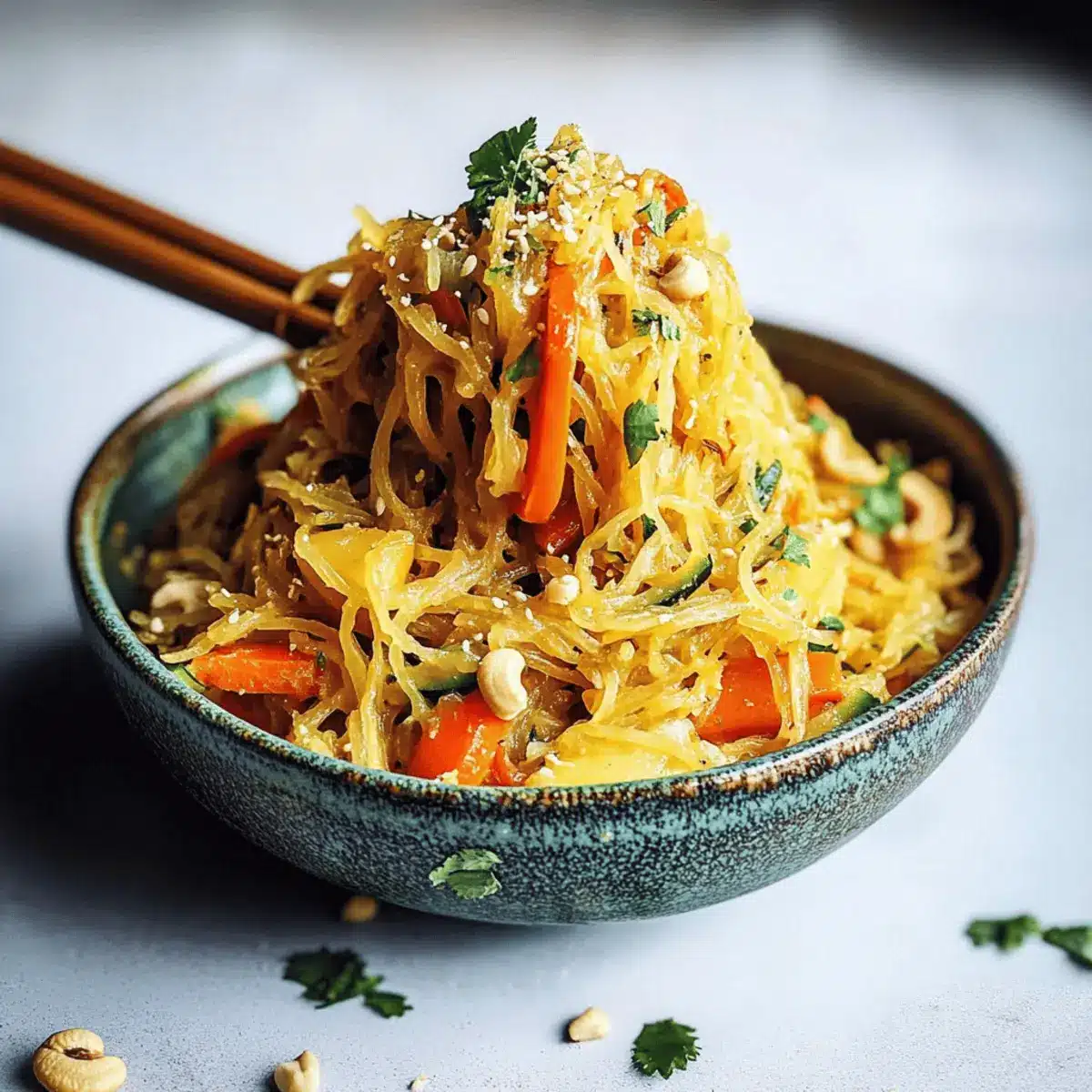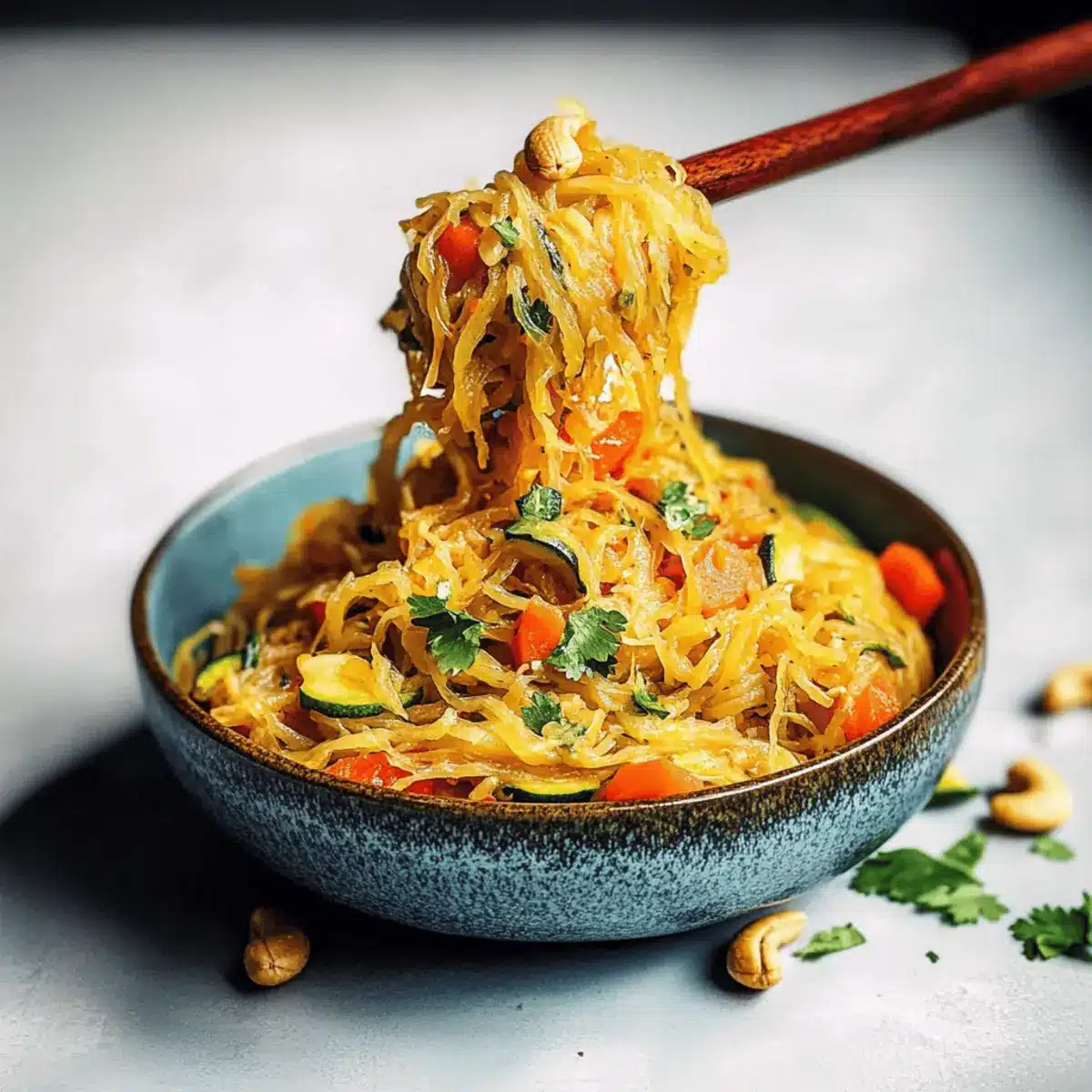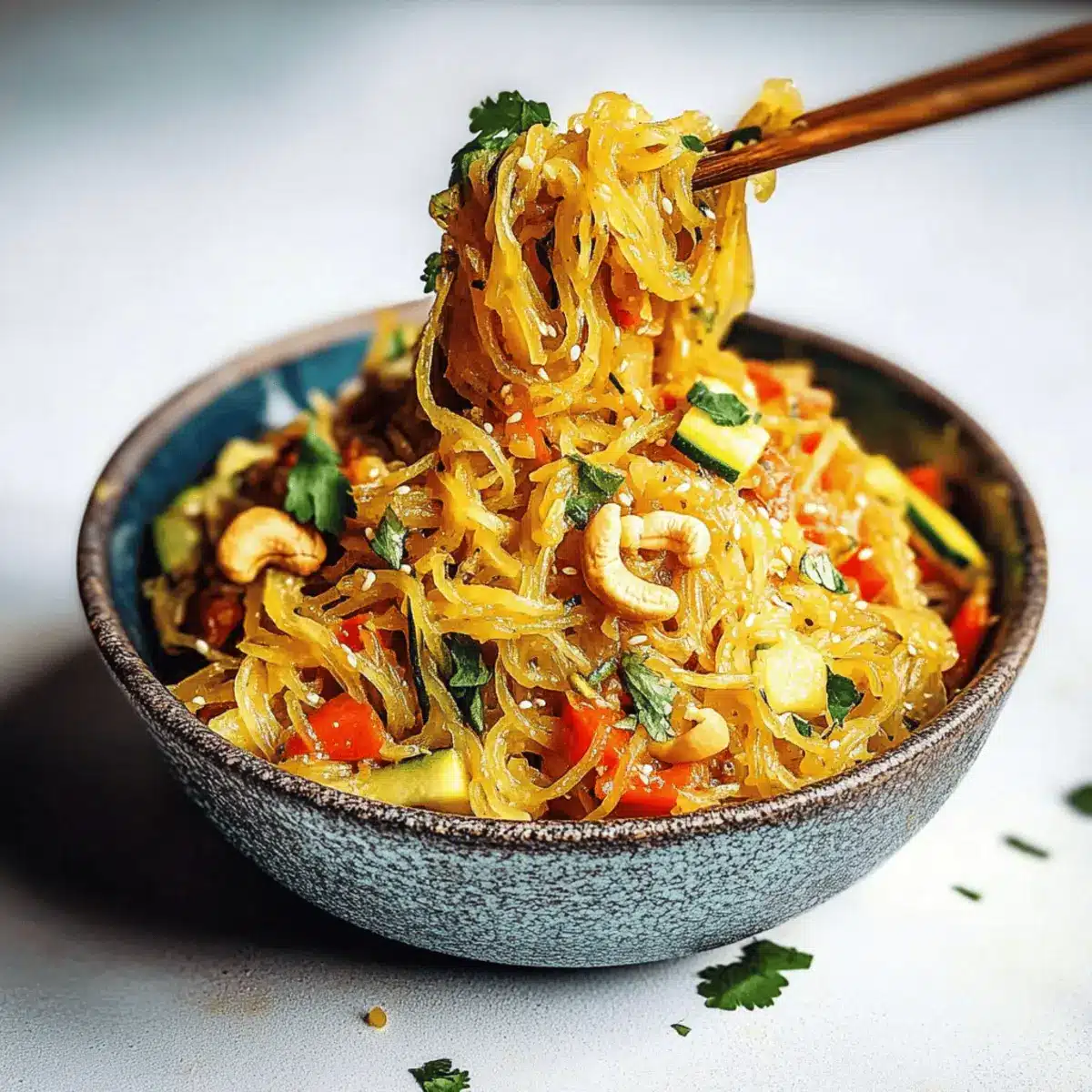As I whisked together the rich, aromatic ingredients of my Whole30 Asian Garlic Noodles with Spicy Coconut Sauce, the kitchen filled with a swirl of savory scents that whisked me far from the everyday meal prep. This dish isn’t just a feast for the senses; it’s a ticket to a delightful, healthier way to indulge in Asian-inspired flavors without breaking any dietary rules. With quick prep and the ability to serve warm or chilled, these noodles are a versatile crowd-pleaser that even a busy weeknight can’t resist. Whether you’re in need of a quick dinner solution or a fresh, fun dish to share with friends, these Asian Garlic Paleo Whole30 Noodles will have you yearning for seconds. Ready to dive into a bowl of vibrant flavors and satisfying textures?

Why are these noodles a must-try?
Versatile & Quick: This recipe is a breeze to whip up, perfect for busy weeknights when you crave something delicious yet healthy.
Vibrant Flavors: The harmonious blend of garlic, ginger, and coconut creates an explosion of taste, ensuring every bite is both comforting and exciting.
Paleo-Friendly: Enjoy the indulgence of noodles without the gluten, allowing you to stick to your Whole30 lifestyle while savoring the rich flavors.
Eye-Catching Presentation: With a colorful mix of fresh veggies, these noodles don’t just taste good—they look fabulous on your dinner table.
Crowd-Pleasing Appeal: Whether served warm or chilled, they’re great for meal prep and guaranteed to impress family and friends. For more tasty dishes, check out my Crockpot Garlic Butter or Garlic Shrimp Over recipes to elevate your dinner game!
Asian Garlic Paleo Whole30 Noodles Ingredients
• Get ready to create a delicious dish that satisfies your taste buds while adhering to Whole30 guidelines!
For the Noodles
- Spaghetti Squash – A fantastic gluten-free noodle alternative that adds a slightly sweet flavor. Note: Cooked spaghetti squash can be made by baking halved squash until tender.
- Zucchini – Provides a refreshing crunch and pairs beautifully with the sauce. Substitution: Any firm vegetables will work well here.
- Carrot – Brings a touch of sweetness with a vibrant pop of color. Substitution: You can julienne it for even cooking or omit if desired.
- Red Bell Pepper – Adds a hint of heat and a splash of color. Substitution: Feel free to use any color bell pepper you prefer.
- Fresh Cilantro – Offers a burst of freshness to the dish. Substitution: If cilantro isn’t available, chopped parsley will work too.
For the Sauce
- Coconut Aminos – A savory alternative to soy sauce that fits within Whole30. Substitution: Soy sauce or tamari (not Whole30) can be used, but make sure to adjust the flavor.
- Coconut Milk – Adds rich creaminess to the sauce. Substitution: Almond milk can be used for a lighter option.
- Fresh Grated Ginger – Delivers warmth and spice for a truly aromatic experience. Note: Ginger powder can be a substitute in lesser amounts.
- Red Curry Paste – Introduces a delightful kick to the sauce. Substitution: Chili paste can work, or omit for a milder dish.
- Fish Sauce – Deepens the flavor profile with its umami notes. Substitution: You can omit it or use a vegan fish sauce alternative for a different flavor.
- Garlic Cloves – Essential for that lovely garlic flavor that compliments the dish perfectly. Note: Smaller cloves result in less heat, if preferred.
- Medjool Dates – Adds natural sweetness balancing out the spice. Substitution: Maple syrup or sugar can provide sweetness, but it might change the Whole30 compliant nature of the dish.
For the Topping
- Roasted Cashews or Peanuts – Provides a satisfying crunch and richness. Substitution: Any nut or seed can work as a topping; be mindful of allergies.
For this delicious Asian Garlic Paleo Whole30 Noodles, each ingredient plays a vital role in creating a dish that’s both satisfying and healthy. Dive into these vibrant flavors and textures as you whip up this quick recipe!
Step‑by‑Step Instructions for Asian Garlic Paleo Whole30 Noodles
Step 1: Prepare the Spaghetti Squash
Start by preheating your oven to 450°F (232°C). Cut the spaghetti squash in half lengthwise, scoop out the seeds, and brush the insides with olive oil. Place the squash halves cut-side down on a baking sheet lined with parchment paper. Bake for 25–45 minutes, until the flesh is fork-tender and easily scrapes into noodle-like strands.
Step 2: Blend the Sauce
While the squash bakes, gather a blender or food processor. In it, combine coconut aminos, coconut milk, fresh grated ginger, red curry paste, fish sauce, garlic cloves, and Medjool dates. Blend on high until the mixture is completely smooth and creamy. This sauce is the star of your Asian Garlic Paleo Whole30 Noodles, so ensure it’s well-blended for even flavor distribution.
Step 3: Scrape the Noodles
Once the spaghetti squash has finished baking, carefully remove it from the oven and let it cool for a few minutes. Using a fork, gently scrape the flesh to create long noodle strands. Transfer the noodles to a large mixing bowl, being careful not to break them too much; they should resemble traditional pasta in texture.
Step 4: Prepare the Vegetables
Next, you’ll want to prepare the accompanying vegetables. Julienne the zucchini and carrot, and slice the red bell pepper into thin strips. Add these vibrant, fresh veggies directly into the bowl with your spaghetti squash noodles. The colors will enhance the appeal of your dish while providing delightful crunch.
Step 5: Combine Sauce and Noodles
Pour the prepared sauce over the mixture of spaghetti squash noodles and vegetables. Toss everything together carefully until the noodles and vegetables are well-coated in the rich, spicy coconut sauce. This step is crucial as it ensures that every noodle is infused with the wonderful flavors of the Asian Garlic Paleo Whole30 Noodles.
Step 6: Serve and Enjoy
Finally, your dish is ready to serve! Present it warm right from the bowl, or if you prefer a refreshing twist, chill it in the refrigerator for about 30 minutes before serving. This dish can be enjoyed as a light main course or a side, making it a versatile option that’s sure to please anyone at the table.

What to Serve with Whole30 Asian Garlic Noodles
The perfect meal is one that tantalizes your taste buds and leaves you feeling satisfied and nourished.
-
Grilled Chicken: The smoky flavor of grilled chicken pairs beautifully with the spicy coconut sauce, adding protein to your meal.
-
Steamed Broccoli: A crisp side that complements the noodles’ textures, steamed broccoli adds vibrant color and a fresh crunch to your plate.
-
Spicy Shrimp Skewers: These delicious shrimp bring a zesty kick, enhancing the Asian flavors of the dish while adding a satisfying protein element.
-
Coconut Rice: Fluffy coconut rice offers a creamy base to balance the noodles’ spice, creating a rich and indulgent fusion of flavors.
-
Miso Soup: A warm, comforting bowl of miso soup provides a soothing contrast to the noodles, deepening the overall experience with its umami richness.
-
Asian Cucumber Salad: Crisp, tangy cucumbers add a refreshing balance to the meal, cutting through the richness of the sauce with a burst of flavor.
-
Lychee Martini: For a touch of fun, this sweet and fruity cocktail captures the essence of Asian flavors, making it a perfect drink to accompany your delicious noodles.
Each of these pairings adds layers of taste, color, and texture, ensuring your Whole30 Asian Garlic Noodles shine in a full meal!
How to Store and Freeze Asian Garlic Paleo Whole30 Noodles
Fridge: Store leftovers in an airtight container for up to 3 days. Allow the flavors to meld, making each subsequent day’s meal even tastier!
Freezer: While not ideal for freezing, if needed, place the noodles in a freezer-safe container for up to 1 month. Thaw in the fridge before reheating.
Reheating: Warm in a skillet over low heat, adding a splash of coconut milk to restore creaminess, or enjoy chilled for a refreshing alternative.
Assembly Tip: If storing combined, consider keeping the sauce separate until serving for best texture and flavor retention of the Asian Garlic Paleo Whole30 Noodles.
Expert Tips for Whole30 Asian Garlic Noodles
-
Taste Adjustments: Tailor the garlic and ginger levels to your spice preference; this recipe is flexible to suit any palate.
-
Smooth Sauce: Use a high-powered blender to achieve a silky sauce. A lumpy sauce can detract from the overall dish experience.
-
Ingredient Checks: Always read labels for fish sauce; some brands may contain added sugar, which does not comply with Whole30 guidelines.
-
Vegetable Choices: Don’t hesitate to switch up your vegetables based on what’s fresh and in season—snap peas or broccoli can add a delightful crunch.
-
Leftover Storage: Store in an airtight container in the fridge for up to 3 days; flavors will meld beautifully as they sit, enhancing your next meal of Asian Garlic Paleo Whole30 Noodles.
Make Ahead Options
These Whole30 Asian Garlic Noodles are perfect for meal prep enthusiasts! You can cook the spaghetti squash and prepare the sauce up to 24 hours in advance. Simply bake the squash and refrigerate it in an airtight container. For the sauce, blend all ingredients and store it in the fridge, ensuring it’s well-sealed to maintain its rich flavor. When you’re ready to serve, scrape the squash into noodles and mix in your prepped vegetables—zucchini, bell pepper, and carrots. Toss everything with the stored sauce, and you’ll have a delicious, time-saving dish that’s just as vibrant and satisfying!
Asian Garlic Paleo Whole30 Noodles Variations
Dive into delicious creativity with these Asian Garlic Paleo Whole30 Noodles, where each variation invites you to explore flavors and textures!
- Protein-Packed: Add grilled shrimp, chicken, or tofu for a high-protein twist that turns these noodles into a satisfying, hearty main dish.
- Seasonal Veggies: Swap in vibrant veggies like snap peas, broccoli, or leafy greens to embrace the seasonality of fresh produce and add delightful crunch.
- Nut Alternatives: Experiment with different nuts like sliced almonds or crunchy sunflower seeds for a unique topping that adds a flavorful twist.
- Spicy Kick: Amp up the heat by incorporating chili flakes or hot sauce into the coconut sauce, bringing an exciting fire to every bite.
- Creamy Twist: Swap coconut milk for a rich cashew cream for added creaminess while keeping within the paleo principles.
- Mild Flavor: Omit the fish sauce for a milder flavor, or use a vegan fish sauce alternative to still enjoy that umami touch without compromising your dietary choices.
- Garlic Lovers: If you’re a garlic aficionado, double the amount of garlic cloves for a robust garlic-packed flavor that’ll have you swooning.
- Zucchini Noodles: For a low-carb option, replace spaghetti squash with spiralized zucchini noodles; just be cautious of water content when cooking.
Feel free to mix and match these variations or create your own whimsical twist! For ideas on other delicious dishes, don’t miss out on my Crockpot Garlic Butter or the flavorful Chinese Honey Garlic for delightful inspiration in your kitchen!

Asian Garlic Paleo Whole30 Noodles Recipe FAQs
How do I choose the right spaghetti squash?
Absolutely! When selecting spaghetti squash, look for a fruit that is firm, yellow-orange, and free from dark spots or soft spots. Heavy for its size is the golden rule—this indicates a juicy inner flesh and fewer seeds. Aim for a medium-sized squash, roughly 3 to 5 pounds, which often yields the best noodles.
What’s the best way to store leftovers?
Very! You can store your Asian Garlic Paleo Whole30 Noodles in an airtight container in the fridge for up to 3 days. The flavors get even better as they meld together! Make sure to let them cool before sealing the container to avoid condensation, which can make them soggy.
Can I freeze Asian Garlic Paleo Whole30 Noodles?
The more the merrier! If you need to freeze them, it’s best to do so before mixing with sauce. Place the cooked spaghetti squash noodles in a freezer-safe container for up to 1 month. For best results, thaw them in the fridge overnight and reheat in a skillet with a splash of coconut milk to regain creaminess. Just remember, the vegetables won’t hold up as well if frozen.
What should I do if my garlic and ginger flavor is too strong?
No worries at all! If you find the garlic or ginger too potent, try mixing in a bit more coconut milk; this will help mellow the flavors. Alternatively, adding another sweet date or splash of coconut aminos can balance it out. Cooking the sauce for a little longer can also help soften those robust flavors.
Are there any allergies I need to watch out for with this recipe?
Absolutely! Keep an eye on the roasted cashews or peanuts, as nut allergies are common. You might consider using seeds, like pumpkin or sunflower seeds, for a delightful crunch without allergens. For fish sauce lovers, opt for a vegan alternative if you or your guests follow dietary restrictions. Always check labels for hidden allergens!
How do I ensure my sauce is perfectly blended?
Great question! To achieve an ultra-smooth sauce, use a high-powered blender or food processor. Start by adding the liquid ingredients first and then layer the solids on top. Blend on high until fully combined, stopping to scrape down the sides as needed. This will ensure there are no lumps, resulting in a luscious and creamy texture that beautifully coats your noodles!

Asian Garlic Paleo Whole30 Noodles for a Flavorful Feast
Ingredients
Equipment
Method
- Preheat oven to 450°F (232°C). Cut spaghetti squash in half, scoop out seeds, brush insides with olive oil, and place cut-side down on a baking sheet lined with parchment paper. Bake for 25–45 minutes until fork-tender.
- While the squash bakes, blend coconut aminos, coconut milk, fresh grated ginger, red curry paste, fish sauce, garlic cloves, and Medjool dates in a blender until smooth and creamy.
- Once the spaghetti squash is done, scrape the flesh with a fork to create noodle strands. Transfer noodles to a large mixing bowl.
- Prepare the vegetables by julienning zucchini and carrot, and slicing red bell pepper into thin strips. Add to the mixing bowl with the spaghetti squash noodles.
- Pour the prepared sauce over the noodles and vegetables. Toss gently until well-coated in the rich sauce.
- Serve warm or chill in the refrigerator for about 30 minutes before serving. Enjoy as a light main course or side.

Leave a Reply